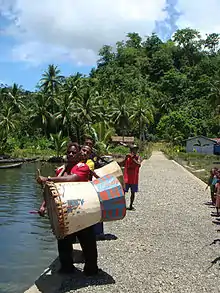.svg.png.webp) Waigeo Location in Raja Ampat Islands  Waigeo Location in Papua | |
| Geography | |
|---|---|
| Coordinates | 0°12′S 130°50′E / 0.200°S 130.833°E |
| Archipelago | Raja Ampat Islands |
| Area | 3,155 km2 (1,218 sq mi) |
| Highest elevation | 958 m (3143 ft) |
| Highest point | Buffalo Horn |
| Administration | |
Indonesia | |
| Province | Southwest Papua |

Waigeo is an island in Southwest Papua province of eastern Indonesia. The island is also known as Amberi, or Waigiu. It is the largest of the four main islands in the Raja Ampat Islands archipelago, between Halmahera and about 65 kilometres (40 miles) to the north-west coast of New Guinea. The Dampier Strait (a.k.a. Augusta's Strait) separates it from Batanta, and the Bougainville Strait from the Kawe Islands to its north-west. The "inner sea" that nearly cleaves the island in two is Mayalibit Bay, also known as the Majoli Gulf.[1][2]
The area of the island is 3,155 square kilometres (1,218 square miles); the highest elevations are 958-metre-high (3,143-foot) Buffalo Horn (Gunung Nok) and 939-metre-high (3,081-foot) Serodjil.[3] From west to east the island measures approximately 110 km (68 mi), north–south about 50 kilometres (31 miles).
The town of Waisai in the south of the island is the capital of the Raja Ampat Regency.
History
Jorge de Menezes, a Portuguese explorer, landed on Waigeo Island in 1526–27.
Islam first arrived in the Raja Ampat archipelago in the 15th century due to political and economic contacts with the Bacan Sultanate.[4] During the 16th and 17th centuries, the Sultante of Tidore had close economic ties with the island.[4][5] During this period, Islam became firmly established and local chiefs had begun adopting Islam.[5]
Alfred Russel Wallace spent some time on the island and studied the flora and fauna during the late 1850s while on his scientific exploration trip.
Since 1997, the island has been the site of a substantial pearl farming operation owned by the Australian company Atlas Pacific.
Languages
Languages spoken on Waigeo include Papuan Malay, Biak, Ma'ya, and Ambel.[6] Their distributions within the island are given below.[7]: 5
Fauna and flora
- Waigeo brushturkey (Aepypodius bruijnii)
- Waigeou cuscus (Spilocuscus papuensis)
- Waigeo rainbowfish (Melanotaenia catherinae)
- Waigeo seaperch (Psammoperca waigiensis)
- Wilson's bird-of-paradise (Diphyllodes respublica)
- Golden-spotted tree monitor (Varanus boehmei)
- Achaea simplex
- Hypochlorosis ancharia
- Hypolycaena phorbas
- Karstarma waigeo
- Nepenthes danseri
Protected Areas
References
- ↑ Victor Émile van Straelen, Résultats scientifiques du voyage aux Indes Orientales Néerlandaises de LL.AA.RR. le Prince et la Princesse Léopold de Belgique, Musée royale d'histoire naturelle de Belgique, 1933
- ↑ "Mayalabit Bay MPA". Raja Ampat Marine Park. Accessed 8 August 2021
- ↑ Pub164, 2004 Sailing Directions (Enroute): New Guinea
- 1 2 Wanggai, Toni V. M. (2008). Rekonstruki sejarah umat Islam di tanna Papua [Reconstruction of the History of lslam in Papua]. Syariff Hidayatullah State Islamic University Jakarta (in Indonesian). Retrieved 2022-03-13.
- 1 2 Slama, Martin (2015), "Papua as an Islamic Frontier: Preaching in 'the Jungle' and the Multiplicity of Spatio-Temporal Hierarchisations", From 'Stone-Age' to 'Real-Time': Exploring Papuan Temporalities, Mobilities and Religiosities, ANU Press, pp. 243–270, ISBN 978-1-925022-43-8
- ↑ Remijsen, Bert, 2001. Word Prosodic systems of the Raja Ampat languages. Utrecht: LOT Publications.
- ↑ Arnold, Laura Melissa (2018). Grammar of Ambel, an Austronesian language of Raja Ampat, west New Guinea (PhD). University of Edinburgh. hdl:1842/31120.
- ↑ UNEP-WCMC (2021). Protected Area Profile for Waigeo Barat Timur from the World Database of Protected Areas. Accessed 8 August 2021. https://www.protectedplanet.net/555635894
- ↑ Raja Ampat Marine Park. Accessed 8 August 2021
External links
 Media related to Waigeo at Wikimedia Commons
Media related to Waigeo at Wikimedia Commons
